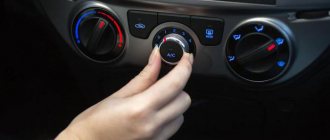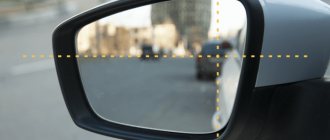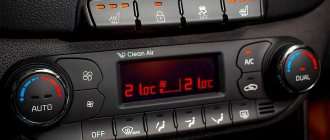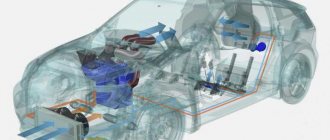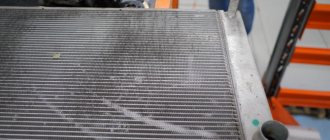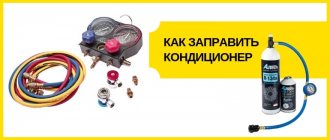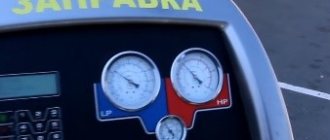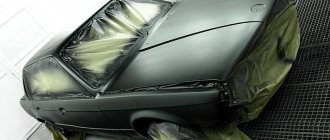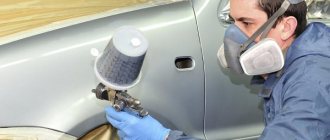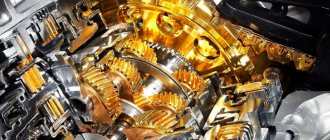Climate warming, which has been talked about so much lately, has led not only to snowless winters, but also to abnormally high temperatures in summer, when the thermometer often rises to the forty-degree mark. We can say that the drivers were the first to experience all the delights of the climate typical of the southern regions. If 50 years ago, to create a comfortable microclimate in the cabin, a conventional ventilation system (together with a slightly open window vent) was sufficient, but today it becomes practically useless. And it’s good if the car has air conditioning - in its absence the driver will have a hard time, especially when driving in dense city traffic, where the average speed rarely exceeds 20 km/h, and therefore open windows not only do not bring life-saving coolness, but also become cause of fumes and dust getting into the cabin.
Instructions for using air conditioning in a car.
Of course, having a car air conditioner is not a panacea, but if used correctly, it can make life on wheels easier for many years. On the contrary, failure to comply with the rules of its operation can cause rapid failure, as well as affect the health of people in the cabin. Knowledge of the operating features of automobile air conditioning systems will also help to avoid unreasonable costs for gasoline/diesel fuel, which in modern conditions is also considered an important factor.
The importance of following advice on operating car climate systems is increasing as automakers gradually make their presence a de facto standard, equipping even frankly budget models with air conditioners.
How a car air conditioner works and much more.
Sometimes it seems to you that outside the window the air temperature is a billion degrees and even the asphalt is melting. At this moment you begin to remember and dream about winter cold and snow. You want to breathe and enjoy the cool air... Fortunately for motorists, most modern cars today are equipped with air conditioning. This allows drivers to drive their car comfortably even in the most unbearable heat. But do you know how to use air conditioner effectively?
Turning on the air conditioning in a car as an option has become such an invisible and appropriate action these days. Sometimes you and I don’t notice when it’s turned on. It’s like a normal and habitual reflex. Most of us don’t even think about or even know how the air conditioning system in cars works. Because of this, you and I often use it not very effectively and do not know how to use it correctly.
Car manufacturers themselves have tried to make air conditioning control as simple and uncomplicated as possible. All you need to do is turn it on and set the required temperature. The air cooling system itself will do the rest for you. But in order to use your car air conditioner more efficiently (for example, to save fuel, which is consumed much more when the air conditioner is on), you need to adhere to certain rules.
How does an airbag work?
Friends, our online publication invites you to learn a few tips on how you can effectively use the air conditioner in your car. But first, let's find out how this air conditioning system works in modern cars.
The automobile air cooling system is a completely closed circuit, in which there is an area of high and low pressure. In the section of the circuit where there is high pressure, the refrigerant (the cooling chemical in this area is in a gaseous state) moves through the system through a special compressor, which is directly connected by a belt drive to the engine. Have you ever paid attention to when you press (press) the “AC” button (turn on the air conditioner)? No? At this moment there is a slight noise under the hood. This turns on the compressor, which supplies gaseous refrigerant to the condenser (radiator), which in turn cools the heated gas turning it into a liquid state.
The liquid, which is under high pressure on the low pressure side, then flows through a special valve into the evaporator. This is where the magic happens friends. The refrigerant in the low pressure area has a very low boiling point and when it reaches the evaporator (actually a simple radiator that is located behind the center console), it immediately turns into gas. This process is called evaporation.
If we remember high school, it will become clear that such evaporation is an endothermic process and means that during such evaporation heat is absorbed. Therefore, many of us should understand that the evaporator itself, located behind the dashboard, begins to cool the air that enters the car from the street through the ventilation system.
This cycle then repeats over and over again.
Now that we have remembered and learned (for those who did not know) how the air conditioner works in a car, let's take a look at a few tips to find out for yourself how you can use the air conditioner more efficiently.
Refrigerant selection
Much in ensuring trouble-free operation of a car air conditioner depends on the correct selection of refrigerant. Of course, if you buy a new car, you don’t need to worry about this. In any case, until the moment when you need to refuel the climate system.
You need to know that for a long time, R12 freon was used in all air conditioning systems (not just automobiles). However, after the influence of anthropogenic factors on climate warming was proven, scientists found that freon is sufficiently responsible for the destruction of the ozone layer, and in the 90s of the last century it was decided to stop using this volatile substance. At normal pressure and temperature, it is in a gaseous state, and R12 is lighter than air, so it rises to the upper layers of the atmosphere without any problems.
The R134a freon that replaced it is environmentally less hazardous, although it is somewhat less efficient. Currently, all climate systems are charged with it, including car air conditioners. However, cars produced before 1993 operate on R12 freon, and the design of first-generation car air conditioners is noticeably different from modern ones - it is not possible to remake them outside the factory workshops.
But this is not what is important: the joint use of these two refrigerants is unacceptable.
Having different chemical compositions and, accordingly, physical properties, they require specific conditions for their operation (the main parameter is the operating pressure in the system). Mixing them is impossible for other reasons. In particular, on older cars, climate control systems use hoses made from ordinary rubber. Contact with R134a freon will cause corrosion of the material. Therefore, modern air conditioning systems use nylon braided hoses that are neutral to R134a.
The search for new, more environmentally friendly and efficient refrigerants continues, and scientists have already announced the emergence of the next generation of refrigerants - freon R744, characterized by even greater environmental friendliness. This was achieved due to more extreme conditions for using this refrigerant in climate control systems (meaning operating pressure). The prospects for switching to the use of this material in air conditioning systems look quite significant, but due to the increasing complexity of the design of air conditioners, one should not expect this to happen tomorrow.
Hiding the car from the sun
The first step towards efficiency is to reduce the load on the air conditioning system itself. Remember, friends, the longer and more powerful the air conditioner operates, the more energy resources it requires, which this system consumes. And this inevitably, as you probably already understood, leads to a significant increase in fuel consumption.
Smell of gasoline in the cabin
In order to save at least a little on fuel consumption and reduce the load on the air conditioning system, you must try not to place your car in direct sunlight in hot weather, which will heat the body and interior of the car to a high temperature, which even the air conditioner will not quickly reduce. Try, friends, to park your car in the shade, namely, next to houses, trees or bushes. When parking your car in the first half of the day, do not forget that while it is in the shade in the first half of the day, it may be exposed to direct sunlight in the second half of the day.
Even if the sun hits the car in the afternoon, this is secondary, since the sun’s activity in the late afternoon will not be so significant. Therefore, remember, friends, if your car is in the sun after 16-00 hours, it will not heat up as much as during the day and it will be much easier for the air conditioner to cool the car.
If you park your car in an open area, where there is no shade and nowhere to hide the car from the sun's rays, then try to use special films to cover the car, which can be used to cover the car windows from direct penetration of the sun into the car interior. This will reduce the greenhouse effect in the car interior, and also protect the interior materials from fading and damage as a result of strong heat.
Modern climate control - different cars with different features
Every self-respecting manufacturer today is developing one or another climate control system to provide maximum comfort and a minimum number of settings for the car owner. These are very technological devices that are becoming more widespread and more modern technologies every year. But there are certain specifics of operating the climate control system that must be taken into account when using this installation. The specifics depend on the characteristics of the system itself:
- climate control with one sensor (which is usually located near the ceiling) does not immediately respond to maintaining the declared temperature, because the climate at the feet of passengers and at the ceiling is always different, such a setting must be adjusted gradually, without sudden changes;
- many sensors in different places allow the driver to relax more and set just the desired temperature, most of these settings work efficiently and offer quite soft default modes;
- modern technological climate controls from leading manufacturers have received a lot of new technologies that allow them to gently and efficiently comply with the established climate limits without changes and too sharp air flows;
- An air conditioner in a car can have various modifications and methods of operation, so it’s worth finding out exactly how this system functions in your car - this will help you operate the device smoothly without harm to it and your health.
It is always worth remembering that high-tech devices protect themselves. For example, modern climate control in a Volkswagen or Lexus will not turn on in the mode required by the driver if we are talking about extreme operating conditions. In this case, the car will warn of a danger to the equipment and begin to gradually increase the required temperature, gently passing all important barriers. Also, modern cars often have a self-diagnosis system, which allows you to quickly identify possible problems and turn off the equipment. Older cars or less expensive cars do not have such systems; this task is transferred directly to the driver. We invite you to watch a short video about the operation of the air conditioner and its maintenance:
Ventilation
If, nevertheless, you were unable to protect your car from strong heating in the sun’s rays and the air in the cabin of your car is somewhat reminiscent of a bathhouse, then open all the doors in the car, but do not rush to turn on the air conditioner. It is best to initially ventilate the interior of your car after opening the doors in order to naturally slightly reduce the air temperature created in the cabin. You can also speed up this ventilation process by opening one of the windows in the car and driving it at low speed (10-15 km/h) for some distance, so that the hot air collected in the cabin is released into the street by the inertia of thrust.
Basic mistakes in using a car air conditioner
Despite the fact that most modern cars have air conditioners, not many car enthusiasts know how to properly use the air conditioner in a car . This leads to discomfort when traveling, especially long-distance ones, as well as the occurrence of colds and pulmonary diseases. There are four main mistakes in total.
- Ventilation . This is done to remove harmful substances formed during the evaporation of plastic interior parts.
- Use only in hot weather . To prevent the windows from fogging up from the outside, you need to turn on the air conditioner first, before the heat sets in, and gradually lower the air temperature.
- Air flow towards you . Cold air flow directed to the chest area can lead to colds and cardiovascular diseases.
- Air temperature is too low . A sharp difference between the outside air and the air in the cabin can lead to colds.
However, in addition to knowing how to use the air conditioner in a car in the summer, you need to know the rules of operation and maintenance. If you make mistakes, your car air conditioner will not only work worse, but may even fail.
Mistakes when servicing the air conditioner in a car
Experts identify eight main mistakes that car owners often make when performing independent air conditioning system maintenance.
- The refrigerant pressure in the system is not checked regularly . It is believed that up to 10% of freon evaporates from the system every year.
- They do not preventively turn on the air conditioner in winter . It is necessary to turn on the air conditioner in winter so that during the cold season the rubber seals and hoses of the system are also lubricated, as well as to prevent corrosion on metal surfaces. You need to turn on the air conditioner only when the car is in a warm room (box, garage) or during a thaw (at a temperature of +2°C...+3°C and above). It is necessary to turn on the air conditioner at least once every three to four weeks.
- They use the wrong freon for do-it-yourself refueling . Before refilling or replacing freon in the system, you need to know exactly what type of freon the manufacturer of the air conditioning system recommends using. Otherwise, a situation may occur when the freon does not match the oil in the compressor, which can lead to rapid failure of the compressor, as well as low efficiency of the entire system.
Disinfection and cleaning of the air conditioning system
- The radiator-evaporator is not treated antibacterially . It should be carried out twice a year - in spring and autumn. The air conditioning system in your car should be cleaned regularly once or twice a year (usually in spring and autumn). You can do this yourself using air conditioner cleaners.
- The air conditioner radiator is not regularly cleaned of debris . This leads to a decrease in system efficiency and creates additional stress on the compressor. Similar problems arise when a mosquito net is installed in front of the radiator, designed to filter dust and debris.
- They fill the system with excess freon . This is typical when refilling freon yourself from a can. This leads to a decrease in the efficiency of the system due to wear and tear under excess pressure. Therefore, it is better not to refuel yourself, but instead seek help from the appropriate car service center.
- The radiator is washed frequently . The radiator and the entire system must be cleaned periodically, but do not overdo it. Frequent washing can lead to corrosion on the metal surface of the radiator, especially if done with active foam.
- They neglect to regularly replace the cabin filter . It must be changed in accordance with the car manufacturer's recommendations. However, on average, the frequency of replacing the cabin filter is about 10...20 thousand kilometers. Using a dirty cabin filter results in the appearance of dust and harmful microbes in the cabin air, as well as unpleasant odors.
Turning on the air conditioner
When turning on the air conditioning system, you must first turn it on to the minimum mode (Low). After all, every system in a car needs a little work before it begins to function more efficiently. You won’t like your friends waking you up in the middle of the night and forcing you to run quickly across some terrain..(?) Likewise, the air conditioning system will not work effectively if it is immediately initially turned on at 100% power. If your car is equipped with an automatic air conditioning mode, then when you turn it on, the system itself will first operate at the minimum mode, and then gradually increase the blowing power.
Temperature changes
According to medical data, the human body reacts sharply to large temperature changes. The optimal change in such conditions is considered to be 3-5 degrees, and drivers are usually completely cooled.
Sometimes the difference between the street temperature and the car temperature is 20 degrees. That is, the heat outside is 40 degrees, and the temperature inside is 20 degrees less, the risk of contracting a serious illness increases significantly.
In addition, it is very important to monitor the condition of the filter in the air conditioner and change it on time. Otherwise, it becomes a source of various infections. And since a car is a closed space, the germs collected there quickly spread and infect a person.
Always use air recirculation
This is one of the most useful modes in modern cars. When it is turned on, the air supply system from the street will not constantly supply “outboard” air into the car’s interior. It will use the air specifically from the cabin, which is already there. Well, the cooled cabin air will relieve the car’s air conditioning system itself. If the air recirculation mode is not turned on, the air conditioner in the car will constantly operate at maximum power, at the same time cooling a portion of the incoming hot air from the street.
Preparing for refueling
First of all, before refueling the air conditioner in the car with your own hands, you need to find and eliminate leaks, as well as perform vacuuming.
If the leaks are small, you can fix them yourself; for larger damages, we recommend contacting a car service center.
Finding and fixing leaks
If the freon in the air conditioner runs out due to damage to the pipes, then in this case you need to find and fix the leak. To find leaks, it is recommended to use a special tool called a leak detector . If there is no such device, then find the leak location as follows:
- Make a liquid mixture based on oil and freon;
- Add a special ultraviolet dye to the mixture;
- Refuel and turn on the air conditioner;
- After 5-10 minutes, take an ultraviolet lamp and shine it on the air conditioner - the damaged areas should turn greenish-yellow.
To eliminate a leak:
- Take a metal pipe and cover the leak with it;
- Place 1 clamp on both sides of the pipe;
- Degrease the place where the clamps are attached (for example, with alcohol);
- Secure the coupling parts with electrical tape.
- Apply glue to the coupling, place the coupling on the pipe and tighten the clamps.
Pressure test
After eliminating leaks, it is necessary to check the integrity of the system. To do this, you should fill the air conditioner yourself with some safe gas (for example, nitrogen).
After refueling, be sure to measure the pressure - if after 30 minutes the pressure has not changed, this means that the system is completely sealed. Otherwise, repair any remaining leaks and repeat the test procedure.
Evacuation of the air conditioner
Now you need to evacuate the device to remove air and moisture droplets from the system. For evacuation you will need a special vacuum pump, and the procedure itself is as follows :
- Turn on the heating system and warm up the car (if this is not done, then a lot of moisture will remain in the evaporator);
- Take the vacuum pump and connect it to the car air conditioner - to do this, attach the pump pipe to the pipe;
- Turn on the pump for 10-15 minutes. After this, close the valve and turn off the pump. Repeat the procedure 2-3 times;
- Finally, turn off the pump and wait 2-3 hours for the temperature and pressure to normalize. After this, you can proceed directly to refueling.
Subsequence
When you arrive at your destination, do not rush to turn off the car engine while the air conditioner is running. This will place a greater load on the electrical power conversion system. First you need to turn off the air conditioner while the engine is running. This can be done in advance when approaching your final destination. Since the air in the cabin of your car is already cooled, turning off the cooling will not quickly heat up the cabin in a short time, and turning off the air conditioning in advance will save you from the formation of a puddle under the car, which usually forms as a result of accumulated condensation. At first glance there is nothing wrong with this. But don’t rush to draw conclusions, friends, not everything is as simple as it seems at first glance. This condensation forms on the cooler in the cabin. The coolant passing through it lowers the temperature of the evaporator to very low values. External hot air entering it meets the cold evaporator, which results in the formation of water droplets. By turning off the air conditioner in advance when driving, you will thereby prevent the formation of harmful microorganisms that appear in the air conditioning system due to moisture.
Neglect of regular antibacterial treatment and replacement of filter elements
Car air conditioning tends to get clogged. Due to the fact that the cabin filter is clogged with dirt, the cabin may:
- unpleasant odors appear;
- bacteria spread, which in turn provoke the development of respiratory diseases.
Dust and dirt settle on this element, which significantly impairs the passage of air flow. All this leads to the fact that the airflow will have to be turned on at full power, reducing the efficiency of the climate system.
Maintenance
Don’t forget, friends, to regularly service your car by changing the cabin air filter. At a minimum, this should be done once a year. We also advise you to treat the ventilation system itself with antibacterial sprays every year. To do this, you need to buy antibacterial agents in advance (preferably a spray, etc.), and then naturally turn on the engine and start the interior ventilation system, not forgetting to turn off the air recirculation. Next, you need to open the hood of the car and spray a little antibacterial agent in the place where the air is taken in. Thus, this antibacterial substance, together with the air, will pass through the entire ventilation system and enter the car interior. Thus, you will protect yourself from the formation of harmful bacteria and microbes in the ventilation system.
Also, sooner or later you will still have to replace the existing refrigerant in this system itself. Friends, carry out this work only at an authorized dealership to avoid damage to the air conditioning system itself, as well as when refilling the coolant into the system, especially when it is not certified by the car company.
Advantages of an autonomous car air conditioner
In principle, the efficiency of both types of portable car air conditioners is approximately the same. If we talk about the cost, then it also lies in the same price range, and this, in principle, is a considerable amount - around a thousand dollars. Therefore, such split systems are installed mainly in trucks and minibuses, as well as in passenger cars equipped with a top hatch. From the point of view of installation complexity, with minimal experience and the appropriate tools, installation into the opening of the upper hatch will take no more than 2 - 3 hours. If this requires cutting out a window (provided that the owner agrees to such tuning), installation will take approximately twice as long.
A water car air conditioner from a cigarette lighter is much easier to maintain; repairing it will also require minimal investment, and from the point of view of energy consumption, this option is much more preferable. One of the main problems is the availability of a water container. For trucks this is not a problem - a 30 - 40 liter tank can be installed, for example, on the rear plane of the cab. It’s not a problem to find a place for water in a minibus, but with a passenger car it’s a little more difficult.
Although, to be honest, for trips within the city, a smaller volume is sufficient, since the water consumption for climate systems of this type is in the range of 2 – 5 liters per hour: the higher the air temperature outside (and in the cabin, respectively), the higher the consumption. Regular tap water is suitable. Periodic maintenance of the tank consists of cleaning and disinfecting it - once a year, usually at the end of the season, a special antiseptic (in the form of powder or liquid) is poured into it, after which the system is thoroughly dried. Of course, you cannot do without using a filter that traps large and medium-sized particles of debris and prevents rapid clogging of pipelines. This air conditioner can be used not only in hot weather, but also in the off-season, if an influx of fresh, dried air is required.
Monitor your fuel consumption
Once again we would like to repeat that any air conditioner installed in a car increases fuel consumption. But you can also reduce this fuel consumption if you set the desired temperature inside the car, which will not differ much from the temperature outside. That is, in other words, we can say that if it is very hot outside, then you should not cool the air in the car to the same temperature as in a refrigerator.
For example, if it is 28 - 30 degrees outside, we advise you to set the cooling temperature to approximately 23 - 25 degrees. By setting this temperature in this way, you will be more comfortable driving the car, and the air conditioning system will not experience a colossal load, consuming extra liters of fuel.
Rules for using air conditioning in a car
Having a fully functional car interior cooling system, you must also follow the rules for using the air conditioner in the car. This will help to avoid completely unexpected troubles in the form of sore throats, vascular spasms, etc. These rules include:
- Ventilation of the interior. If the car has been parked in the sun and has become very hot, you should not turn on the climate control system at full power immediately after you start the engine. Manufacturers recommend opening all windows for ten minutes and ventilating the interior. Then the windows are closed and you can turn on the air conditioning in the car to one, and set the temperature regulator to medium. After a few minutes, you can switch to two and the lowest possible temperature. It is advisable to do all this while the car is moving, as this removes part of the load directly from the air conditioner, and the desired temperature in the cabin will reach much faster.
- Do not direct cool air onto the glass. This rule is especially relevant when the atmospheric temperature rises above 25 degrees. If the direction of the air stream is incorrect, a critical temperature difference can occur, which will lead to the formation of small microcracks on the glass. This process will gradually progress, and the cracks will soon begin to increase.
- The cooling mode must be correct. Many people are concerned with the question of how not to get sick from turning on the air conditioner in the car, but everything is quite simple. Doctors strongly do not recommend staying in the cabin for a long time when the climate system is operating in maximum mode. Very low temperatures can cause hypothermia and, as a result, colds. After quickly cooling the interior, it is very advisable to set the regulator to “one” and increase the temperature to 20 or 22 degrees. If the climate system has mechanical control rather than digital control, it is best to place the regulator in the middle. Air flows are optimally directed to the legs. All these measures will help everyone who is in the car not to catch a cold or develop a runny nose or sore throat.
- Air flow regulation. If there is a need to quickly cool the car interior, it is best to turn on air circulation in internal mode. By doing this, we force the air to move in a closed cycle, and the air flow from behind the “side” of the car is completely limited. This method is most often used at very high air temperatures or when the vehicle is parked.
- Correctly distribute the flow of cooled air. All car air ducts are equipped with deflectors - a kind of curtains. They are designed to adjust the direction of incoming air flows and it is very desirable to direct them correctly and adjust the intensity of the flows. The car owner's goal will be to properly distribute these flows to ensure uniform cooling of the entire cabin.
The beginning of the story
The beginning of the history of mini-air conditioners can be considered a table fan. These compact devices with blades were connected to the on-board 12 Volt network and circulated air around the cabin.
But the fans did not allow outside air to be taken in and did not cool it. They simply ensured the circulation of the air that was inside the machine. The device had a small effect, but in the sultry heat the driver still experienced discomfort.
And then manufacturers thought about how to make the device more suitable for cooling. Not so long ago, a so-called manual air conditioner appeared, which you can easily connect to the car’s cigarette lighter with your own hands and enjoy the flow of cold air.
Successful advertising and focusing attention on those whose cars do not have a split system have made these devices popular. Go to Avito or Aliexpress and see how many mini-conditioners are sold there.
But does such a device really do what the manufacturer claims? Let's find out the features of the air conditioner, and you can decide for yourself whether it is worth buying something like this or not.
About the European practice of using autonomous air conditioners
If someone may find the argument about the need to ensure the operation of the car air conditioner when the engine is turned off unconvincing, then it will be very useful for them to know that a number of southern European countries have introduced restrictions on the use of vehicles that are not equipped with parking cooling systems. This mainly concerns truck drivers, on whose well-being road safety largely depends. The fact is that if the car is not equipped with air conditioning that can operate at night (and 30-degree temperatures at night today do not surprise anyone), its driver must spend the night in a hotel.
Otherwise, a full night's rest is out of the question (sleeping with the windows open is not an option, since in this case the risk of theft and illegal entry of unauthorized persons into the cabin increases). The fact of being in a hotel must be confirmed by an appropriate receipt, but in the EU hotels are quite an expensive pleasure. So a much more profitable solution is to install a portable car air conditioner. They say that the adoption of the aforementioned restrictive measures was spurred by the increasing number of accidents caused by the poor condition of drivers (simply put, due to overheating). Cases of deaths due to heat stroke received while driving have also been recorded.
We recommend: Changing the coolant on the VAZ 2114 model
Let's start with the basics
The first step to make the air conditioner work easier is to park the car in shaded areas. Of course, finding the perfect spot in huge parking lots every time is almost impossible, but remember this to leave your car in the shade whenever possible.
We also recommend finding out where the shadow of a tree or building will be at a certain time when you go to work. If certain parking spaces are in direct sun during the first part of the day, there is a high chance that they will be in the shade during the second part of the day. Look for such places and leave your car there.
Even if your car gets hot during the day, shade can help reduce its temperature during the day. So you don't have to ride in a stove on wheels when you leave the office.
If you park in a large open parking lot, it will not hurt to use special protective elements that are installed on car windows. This will reduce the greenhouse effect inside.
Features of air conditioning then and now
The refrigerant fills the entire air conditioning system of the car. At first, the system was filled with R12 freon, but it was later discovered that it was unsafe for humans. This problem is more serious than another question that many drivers have: when the air conditioning is turned on, the car jerks. Therefore, we had to look for an urgent replacement, which did not take long to arrive - freon R134a. True, the new refrigerant is less efficient, but it does not pose a danger to the human body.
Due to the fact that the new gas has increased fluidity, the work of engineers has become significantly more complicated. In addition, the new product has finally put an end to the possibility of using the old R12 freon. This is due to the fact that each refrigerant uses a different oil to lubricate the compressor. The old refrigerant used mineral oil, while R134a Freon requires polyalkylene glycol lubricant. Thus, old and new generation freons are incompatible with each other.
To avoid any problems, manufacturers place a special sticker under the hood that indicates the brand of refrigerant. And to make sure there is no confusion, these labels are different colors. Freon R134a is identified by a green color, and R12 by a yellow tint.
